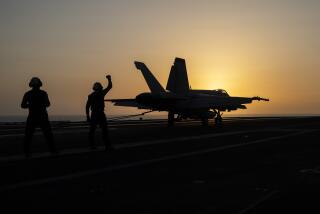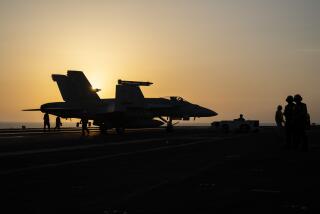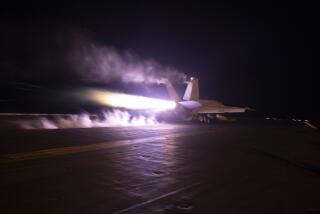Stray Missiles Force Sea Change
WASHINGTON â U.S. Navy warships prepared Sunday to move from the eastern Mediterranean and the Red Sea to the Persian Gulf after several cruise missiles they fired went astray, prompting both Turkey and Saudi Arabia to demand that the missile launches through their airspace stop.
Seven Tomahawk missiles launched from U.S. ships toward Iraq have gone off course, landing on Turkish or Saudi Arabian soil. The missiles did not explode and no injuries resulted, but the incidents touched off angry outbursts in both countries.
On Sunday, for the second day in a row, a convoy of U.S. military trucks came under attack by stone-throwing demonstrators in Turkeyâs southeastern Urfa province, where three stray cruise missiles fell near separate villages last week.
On Saturday, 10 U.S. soldiers arriving at a village to recover a misfired Tomahawk cruise missile came under attack as more than a dozen angry residents pelted their convoy with eggs and stones, smashing the windows of all four vehicles, witnesses said.
The soldiers left after paying $1,000 cash each to two farmers who claimed damages when the missile gouged a crater in their fields early Friday, news channel CNN Turk reported. It quoted one of the farmers as saying the Americans bargained them down from their opening demand of $5,000.
The Pentagon downplayed the strategic importance of having to move the ships. The Saudi and Turkish decisions to ban the Tomahawks did not affect manned combat flights, officials said, and would not impair the United Statesâ ability to strike Iraq with missiles.
Missiles fired from the Persian Gulf pass over Kuwait.
âOne of the great things about where weâre postured is the ability to target from a number of locations ... so it really wonât have a big effect,â said Army Maj. Gen. Stanley A. McChrystal, vice director of operations for the Joint Chiefs of Staff.
Turkey revoked the use of its airspace for the cruise missiles Friday and Saudi Arabia followed suit Saturday. Both governments left open the possibility of changing their minds, but they want the errant strikes thoroughly investigated first.
The Pentagon has used the satellite-guided explosives for critical parts of the campaign, firing 675 of them as of Saturday, including several that struck a Baghdad bunker where Iraqi President Saddam Hussein was believed to be staying in the opening volley of the war on March 20.
The 18-foot missiles can carry 1,000-pound explosives to their targets deep in Iraq from ships hundreds of miles out at sea, their path visible to the naked eye as they skim as close as 100 feet from the ground. Pentagon officials had no immediate explanation for the misfired missiles. But Tomahawks had a failure rate of 17% in prewar testing, according to Paul Beaver, a defense consultant at Ashbourne Beaver Associates in Westminster, England.
Malfunctioning cruise missiles typically fail to explode because they are electronically pre-set to arm themselves a few hundred yards from the target. When they fall short, they damage only what they hit directly. âItâs a big deal only if youâre sitting under one,â Beaver said.
*
Hendren reported from Washington and Boudreaux from Turkey.
More to Read
Sign up for Essential California
The most important California stories and recommendations in your inbox every morning.
You may occasionally receive promotional content from the Los Angeles Times.










